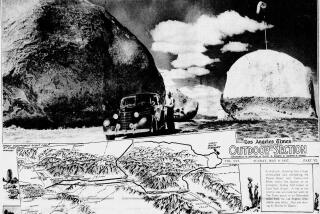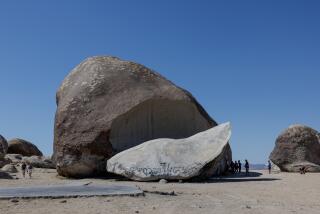How to capture a stone
- Share via
Maybe you can’t reinvent the wheel, but you can reinvent a wheel-shaped stone. Monolithic Sculptures Inc., whose “rocks” are featured at the Spot in Boulder, Colo., and other high-end gyms, is doing just that with a popular geological phenomenon found outside Kansas City.
The company is replicating a rock from a giant cue-ball formation called Rock City.
The company’s president and artistic director, Ty Foose, says his firm takes its lead from the stones themselves rather than from a specific climbing route or bouldering problem. His crew tries to match the real rock in color, shape and texture.
To mimic Mother Nature as closely as possible, Foose and lead designer T.J. Mahlin choose a style of rock based on its climbable appeal and beauty.
The Rock City boulder in Minneapolis, Kan., is part of a series of “huge sandstone concretions — round balls of sandstone that look like massive billiard balls sitting on the plains of Kansas,” says Foose.
Foose liked these formations because “they’re great sculpturally, and just an improbable piece of nature. Also, the rock lends itself to a fun style of climbing.”
The replication began with a three-dimensional foam model, which was scanned into a computer program that created a blueprint for cutting and jig-sawing shapes from a long, rectangular foam block.
Once the foam pieces were cut, designers attached them to a structural steel frame.
Then the sculpting began, using a spray-on concrete shell coating, a malleable material that Monolithic Sculptures uses to carve climbable features, such as cracks and pockets, in the rocks.
The Rock City replica has several layers of coating, the top one detailing the rock’s texture. Once the concrete sculpting is complete, artisans paint the stone to re-create striations, water streaks and mineral deposits.
— Shermakaye Bass
More to Read
Sign up for The Wild
We’ll help you find the best places to hike, bike and run, as well as the perfect silent spots for meditation and yoga.
You may occasionally receive promotional content from the Los Angeles Times.










